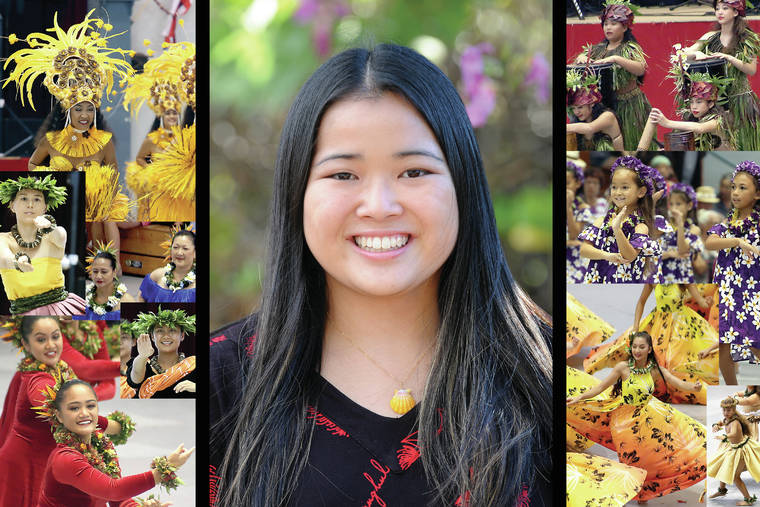Understanding the 56th annual Merrie Monarch Festival

When people think of Hawaii, one of their first thoughts is hula.
When people think of Hawaii, one of their first thoughts is hula.
Maybe it was attending their first luau show — seeing dancers graciously sway their hips from side to side in long grass skirts, or significant memory of the islands.
However, there’s more to it. Although some may not know, or are foreign to its deeper meaning, Hula is a significant part of the Hawaiian culture and is something everyone can learn to love and appreciate — just like any art form.
As a hula dancer of 15 years, when I think of hula, I remember everything I learned growing up in Hawaii — my Hawaiian history classes, May Day performances, my halau, and using this dance as a form of expression.
King David La’amea Kalakaua once said, “Hula is the language of the heart. Therefore the heartbeat of the Hawaiian people” — a statement brought to life at every Merrie Monarch festival.
When Christian missionaries came to the islands, their teachings suppressed many Hawaiian beliefs and traditions. King Kalakaua is known for revitalizing the Hawaiian arts. In 1886, at his 50th birthday celebration — known as the “Silver Jubilee” — chanters and dancers performed in public for the first time in years.
In 1963, Helene Hale, the County of Hawaii chairwoman at the time, decided to look into the tourism industry to give the Big Island an economic boost after the devastating tsunami a few years earlier. A committee was formed and the first Merrie Monarch Festival was created. It included events like a King Kalakaua beard look-alike contest, a relay race, and a recreation of the King’s Coronation.
Over time, interest in the festival began to weaken until Dottie Thompson reshaped the goals of the festival to replicate the legacy of King Kalakaua. In 1971, the festival’s first hula competition took place.
The Merrie Monarch Festival remains an iconic Hawaii event, as some of the best hula halau from the islands and the world gather at the Edith Kanakaole Stadium in Hilo to compete, honor the legacy of King Kalakaua and perpetuate the Hawaiian traditions, native language, arts and hula.
The week-long celebration includes an exhibition night of hula and folk dance from around the pacific, a Hawaiian arts and crafts fair, and a parade.
Yet, the three-night hula competition remains a festival favorite.
The first competition is “Miss Aloha Hula” and involves individual women performing a hula kahiko (ancient style), a hula auana (modern dance style) and an oli (chant). At the end of the night, one winner is crowned with the coveted title.
The next evening, the Group Hula Kahiko competition commences where both kane (men) and wahine (women) halau perform. Finally, is the Group Hula Auana night where the same halau perform graceful modern dance styles.
For both types of performances, dancers may use implements like an ipu (single gourd drum), uli’uli’s (feathered gourd rattles or wooden kala’au sticks.
Awards are presented at the conclusion of the final night of competition.
The Merrie Monarch winners are determined by judges who score the kahiko and auana performances. Some performance elements the judges evaluate are: expression, posture, precision, hand gestures and feet/body movement. The dancer’s appearance — authenticity of the costume, adornments and grooming — is also judged with its relativity to the time period of the chant or song being performed.
Though its grace appears simplistic, mastering the art form of hula comes through many hours of practice.
First, is learning the choreography — the fluid combination of hands, feet, hip movements, and arranged to the music. Then, kumu hula (hula instructors) may implement various line-up transitions or formations within the opening, body or exit of the song. Finally, comes perfecting.
Dancing hula can be compared to paddling a canoe. Dancers must use their peripheral vision to be in sync with one another hitting every motion at the same time with precision — similar to how paddlers’ strokes synchronously align with each other.
Learning how to dance hula for the first time can be difficult, especially when it comes to the technicality aspect.
In college, I am involved with Pua’ikeana, Chapman University’s Hawaii club. For the past four years, I have been part of our annual luau. As a club, we learn different types of Hawaiian — hula Auana and hula kahiko — and Polynesian dances to perform for an audience of hundreds. For these dances, I have assisted in teaching club members hula, from the basic steps, to the choreography. A lot of the members have never danced hula or performed in front of a crowd before, and in preparation for luau, many express that hula is “harder than it looks.”
However, like any type of dance or sport, I love the accomplishment of seeing the club members progression from starting out with no knowledge of the dance to having everything come together on the luau show day, and seeing the joy on their faces after performing.
Hula is something that will always connect me back to my roots here in Hawaii, something I very much appreciate. I have been live-streaming the Merrie Monarch Festival in my dorm room for the past four years and am excited to watch it this year. Whether it’s the perpetuating of culture, the entertainment, the competition or fascination of the art, hula is something many can learn to understand, love, and appreciate.
The 56th annual Merrie Monarch festival continues through Saturday. The three-night competition is televised on KFVE and runs Thursday through Saturday.
Tianna Morimoto interned for West Hawaii Today during the winter. Morimoto, who grew up in Kona, shares her love and knowledge of hula through this column in celebration of the 56th annual Merrie Monarch Festival.


